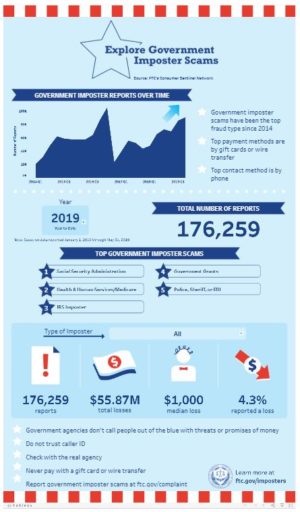Odds are good you’ve gotten the calls that seem to be from the Social Security Administration—or the IRS, or Medicare, or any number of other official agencies. Except, as soon as the caller threatens you or demands that you pay them with a gift card or by wiring money, you should know it’s a scam. Even if Caller ID tells you otherwise–it’s not the government calling.
We’ve talked about this here on the blog before. Last year, in fact, the FTC warned us all about the rise in government scams. Now they have new data—and a new way to see the data—to prove it.
First, let’s get to the big takeaways: There have been 176,259 reports of government impostor scams for the first five months of this year alone. Consumers are reporting they’re getting calls from—and losing money to—scammers pretending to be the IRS, Medicare, a government grants group, or cops and the FBI.
In fact, the FTC data shows these are the top five scams so far in 2019:
- Social Security Administration scams. Consumers have lost a total of $14.71 million in these scams since January of this year! With that kind of success in getting people’s Social Security Numbers and/or money, scammers aren’t going to give up this one any time soon.
- Health & Human Services/Medicare scams. Scammers call, pretending to be from Medicare, and ask for personal information and/or Medicare numbers. They’ll also ask for money, claiming they’ll send you a new Medicare card. The median lost for health-related swindles is $500.
- IRS impostor scams. The median loss for consumers is $1,000 when they fall for an IRS scam. In fact, the total losses across the country adds up to $1.16 million!
- Government grant scams. Those “free” grants to pay for education expenses, home repairs, or unpaid bills? They’re not for real—but people are still handing over their banking information so the grant can be “deposited.” The median loss for these scams is $500 (and in 2018, consumers lost $4.18 million).
- Police, Sheriff, or FBI scams. You may be told that someone you love or care about is in jail and that you need to bail them out, but don’t do it. This scam has stolen $5.10 million from families with a median loss of, gulp, $3,000.
 Don’t take our word for it, check out the FTC’s interactive Data Spotlight graphic. You can explore the data and find out information for different years and the different types of scams –it’s quite a wow.
Don’t take our word for it, check out the FTC’s interactive Data Spotlight graphic. You can explore the data and find out information for different years and the different types of scams –it’s quite a wow.
The FTC says:
Exploring the data can tell you, for example, that this year’s median losses to law enforcement impostors are the highest of all impostor scams (a whopping $3,000), and that 20% of the people who reported those scams told us they lost money. Those calls work because they’re scary.
But now you can stay on top of the latest as data is updated every quarter. Or go back 5 years and see how things have changed.
Along the bottom of the graphic are buttons so you can share and download the guide if you’d like to spread the word to family and friends. Also note, along with the data are the FTC’s tips for how to spot government impostor scams:
- Remember: Government agencies don’t call people out of the blue with threats or promises of money.
- Do not trust Caller ID. It can be spoofed!
- If you think the call might be for real, hang up and call the agency in question using a number YOU research and find.
- Never, ever pay using a gift card or a wire transfer
If you think you’ve fallen for a scam, please help your fellow Americans by reporting it to fts.gov/complaint. For more FTC information about each of these scams, check out these resources:


